A Climatological Study of Successive Tropical Cyclone Events in North Atlantic
Abstract
:1. Introduction
2. Concept, Data and Methods
2.1. Successive Tropical Cyclone (STC)
2.2. Data
2.3. Methods
3. Temporal and Spatial Characteristics of STCs
4. Composite Analysis of Favorable Factors for STC Occurrence
4.1. Mean Circulation Patterns
4.2. Signals at Different Time Scales
5. Discussions and Conclusions
Author Contributions
Funding
Institutional Review Board Statement
Informed Consent Statement
Data Availability Statement
Acknowledgments
Conflicts of Interest
References
- Grinsted, A.; Ditlevsen, P.; Christensen, J.H. Normalized US hurricane damage estimates using area of total destruction, 1900–2018. Proc. Natl. Acad. Sci. USA 2019, 116, 23942–23946. [Google Scholar] [CrossRef] [PubMed]
- Doocy, S.; Dick, A.; Daniels, A.; Kirsch, T.D. The human impact of tropical cyclones: A historical review of events 1980-2009 and systematic literature review. PLoS Curr. Disasters 2013, 5, 1–39. [Google Scholar] [CrossRef] [PubMed]
- Vecchi, G.A.; Landsea, C.; Zhang, W.; Villarini, G.; Knutson, T. Changes in Atlantic major hurricane frequency since the late-19th century. Nat. Commun. 2021, 12, 4054. [Google Scholar] [CrossRef]
- Smith, A.B.; Katz, R.W. US billion-dollar weather and climate disasters: Data sources, trends, accuracy and biases. Nat. Hazards 2013, 67, 387–410. [Google Scholar] [CrossRef]
- Knabb, R.D.; Rhome, J.R.; Brown, D.P. Tropical Cyclone Report: Hurricane Katrina. Available online: https://www.nhc.noaa.gov/data/tcr/AL122005_Katrina.pdf (accessed on 22 September 2022).
- Blake, E.B.; Gibney, E.J.; Brown, D.P.; Mainelli, M.; Franklin, J.L.; Kimberlain, T.B. Tropical Cyclones of the Eastern North Pacific Ocean, 1949–2006; Hammer, G.R., Ed.; Historical Climatology Series; National Hurricane Center: Miami, FL, USA; National Climatic Data Center: Asheville, NC, USA, 2008; Volume 6-2. [Google Scholar]
- Gray, W.M. Tropical cyclone genesis in the Western North Pacific. J. Meteorol. Soc. Jpn. 1977, 55, 465–482. [Google Scholar] [CrossRef] [Green Version]
- Gray, W.M. Hurricanes: Their formation, structure and likely role in the tropical circulation. Meteorol. Over Trop. Ocean. 1979, 77, 155–218. [Google Scholar]
- Krouse, K.D.; Sobel, A.H. An observational study of multiple tropical cyclone events in the western north Pacific. Tellus A 2010, 62, 256–265. [Google Scholar] [CrossRef]
- Gao, J.; Li, T. Factors Controlling Multiple Tropical Cyclone Events in the Western North Pacific. Mon. Weather. Rev. 2011, 139, 885–894. [Google Scholar] [CrossRef] [Green Version]
- Gao, J.Y.; Li, T. Interannual variation of multiple tropical cyclone events in the western North Pacific. Adv. Atmos. Sci. 2012, 29, 1279–1291. [Google Scholar] [CrossRef]
- Aiyyer, A.; Molinari, J. MJO and tropical cyclogenesis in the Gulf of Mexico and eastern Pacific: Case study and idealized numerical modeling. J. Atmos. Sci. 2008, 65, 2691–2704. [Google Scholar] [CrossRef] [Green Version]
- Ventrice, M.J.; Thorncroft, C.D.; Roundy, P.E. The Madden–Julian oscillation’s influence on African easterly waves and downstream tropical cyclogenesis. Mon. Wea. Rev. 2011, 139, 2704–2722. [Google Scholar] [CrossRef]
- Schreck, C.; Molinari, J. Tropical cyclogenesis associated with Kelvin waves and the Madden–Julian oscillation. Mon. Weather Rev. 2011, 139, 2723–2734. [Google Scholar] [CrossRef]
- Schenkel, B.A. A Climatology of Multiple Tropical Cyclone Events. J. Clim. 2016, 29, 4861–4883. [Google Scholar] [CrossRef]
- Schenkel, B.A. Are Multiple Tropical Cyclone Events Similar among Basins? J. Clim. 2017, 30, 5805–5813. [Google Scholar] [CrossRef]
- Landsea, C.W.; Franklin, J.L. Atlantic Hurricane Database Uncertainty and Presentation of a New Database Format. Mon. Weather Rev. 2013, 141, 3576–3592. [Google Scholar] [CrossRef]
- Kalnay, E.; Kanamitsu, M.; Kistler, R.; Collins, W.; Deaven, D.; Gandin, L.; Iredell, M.; Saha, S.; White, G.; Woollen, J.; et al. The NCEP/NCAR 40-year reanalysis project. Bull. Amer. Meteor. Soc. 1996, 77, 437–470. [Google Scholar] [CrossRef]
- Rudeva, I.; Gulev, S.K. Composite analysis of North Atlantic Extratropical cyclones in NCEP-NCAR Reanalysis data. Mon. Weather Rev. 2011, 139, 1419–1446. [Google Scholar] [CrossRef] [Green Version]
- Athanasiadis, P.J.; Yeager, S.; Kwon, Y.O.; Bellucci, A.; Smith, D.W.; Tibaldi, S. Decadal predictability of North Atlantic blocking and the NAO. npj Clim. Atmos. Sci. 2020, 3, 20. [Google Scholar] [CrossRef]
- Duchon, C.E. Lanczos filter in one and two dimensions. J. Appl. Meteor. 1979, 18, 1016–1022. [Google Scholar] [CrossRef]
- Slingo, J.; Palmer, T. Uncertainty in weather and climate prediction. Phil. Trans. R. Soc. A 2011, 369, 3694751–3694767. [Google Scholar] [CrossRef]
- Jones, C.; Waliser, D.E.; Gautier, C. The Influence of the Madden–Julian Oscillation on Ocean Surface Heat Fluxes and Sea Surface Temperature. J. Clim. 1998, 11, 1057–1072. [Google Scholar] [CrossRef]
- Krouse, K.D.; Sobel, A.H.; Polvani, L. On the wavelength of the Rossby waves radiated by tropical cyclones. J. Atmos. Sci. 2008, 65, 644–654. [Google Scholar] [CrossRef]
- Wen, M.; Li, T.; Zhang, R.; Qi, Y. Structure and origin of the quasi-biweekly oscillation over the tropical Indian Ocean in boreal spring. J. Atmos. Sci. 2010, 67, 1965–1982. [Google Scholar] [CrossRef]
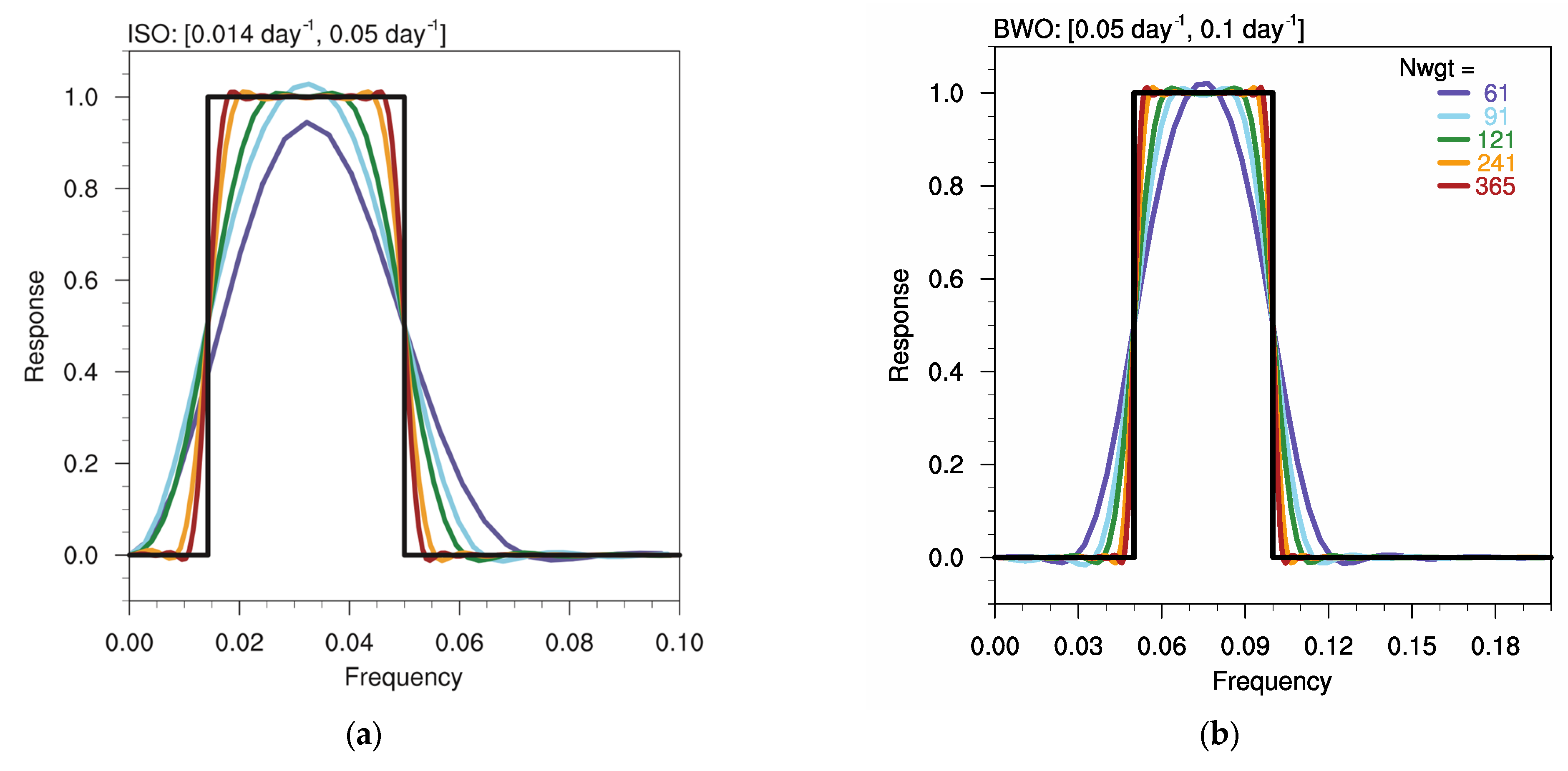
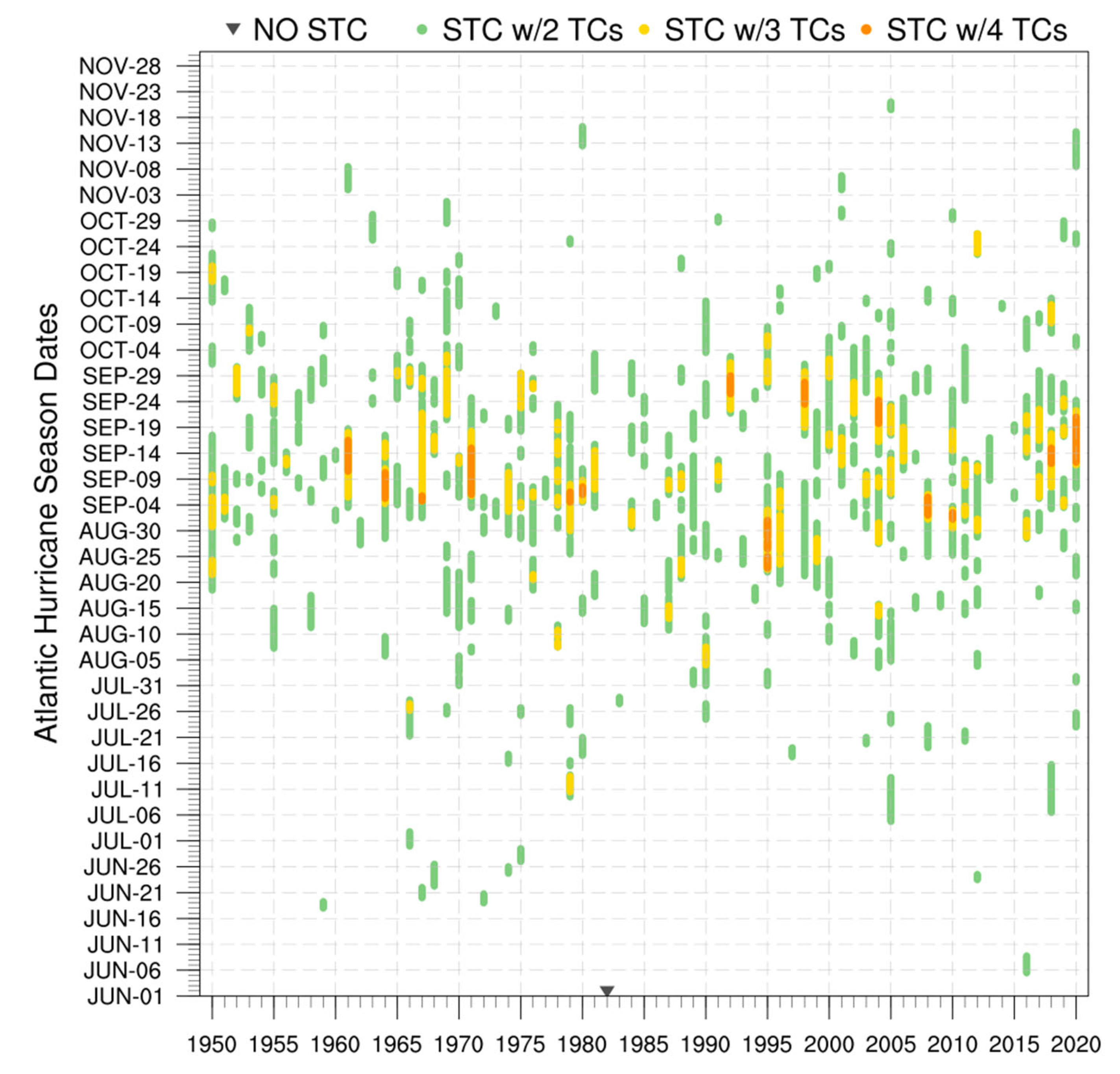
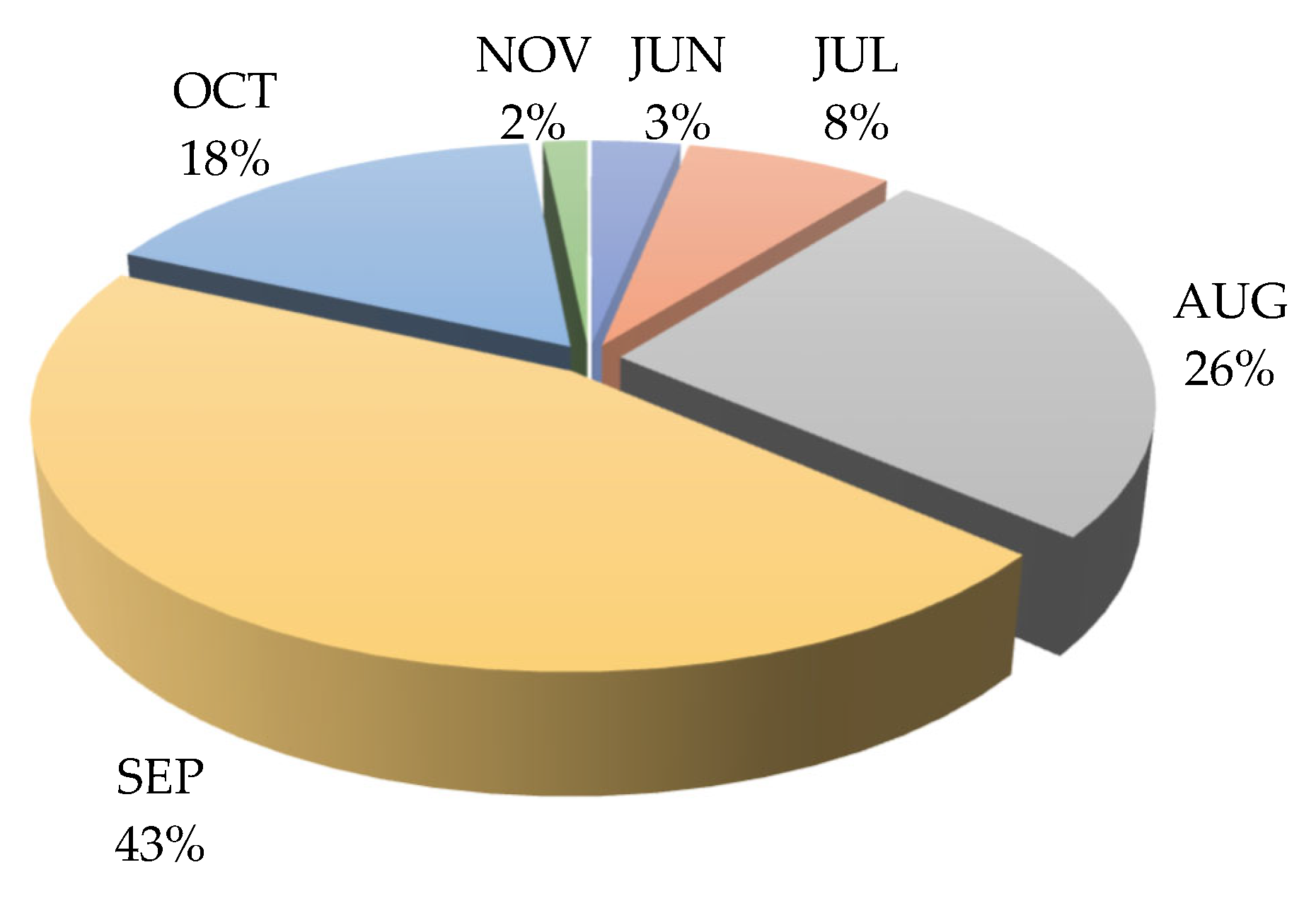


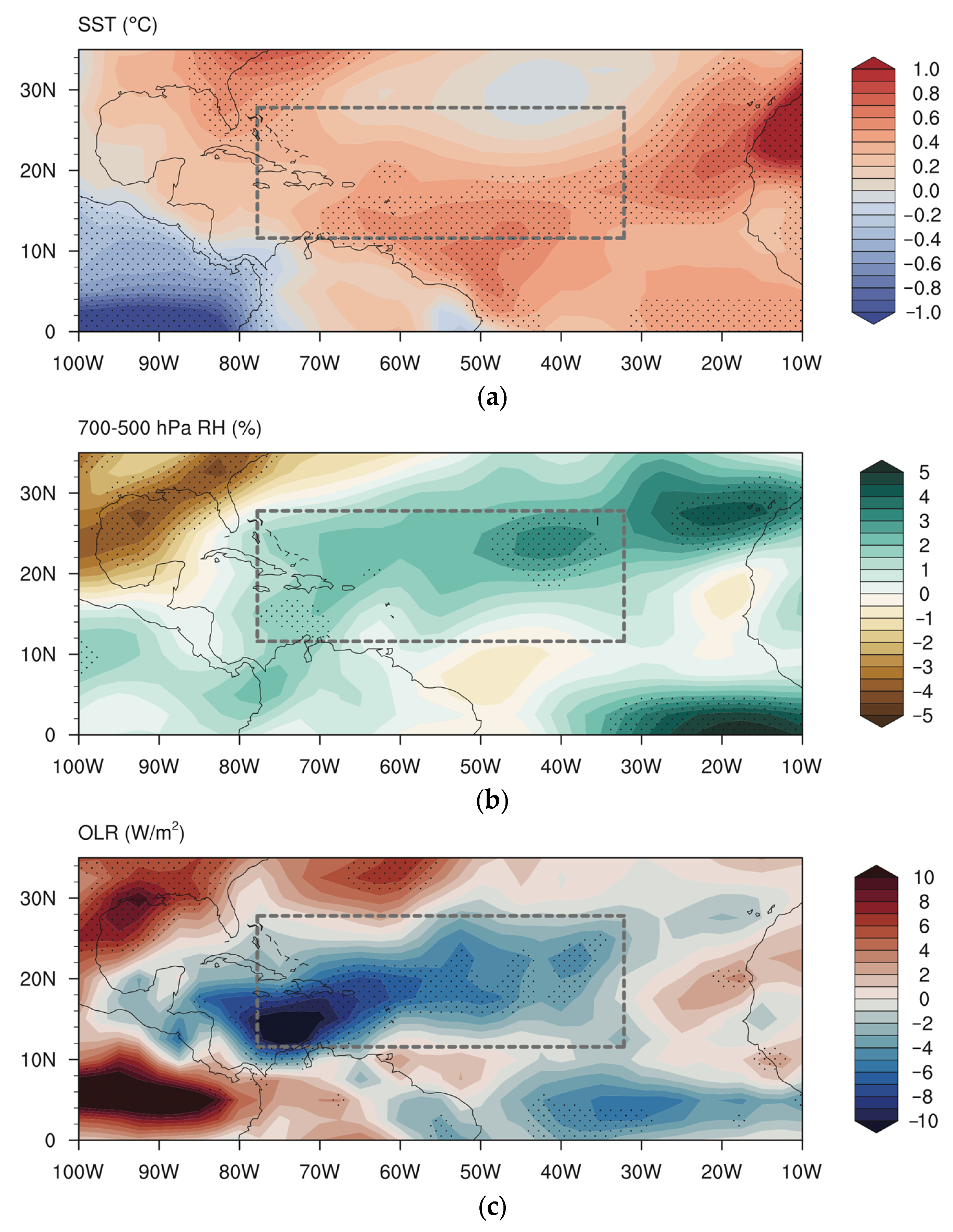

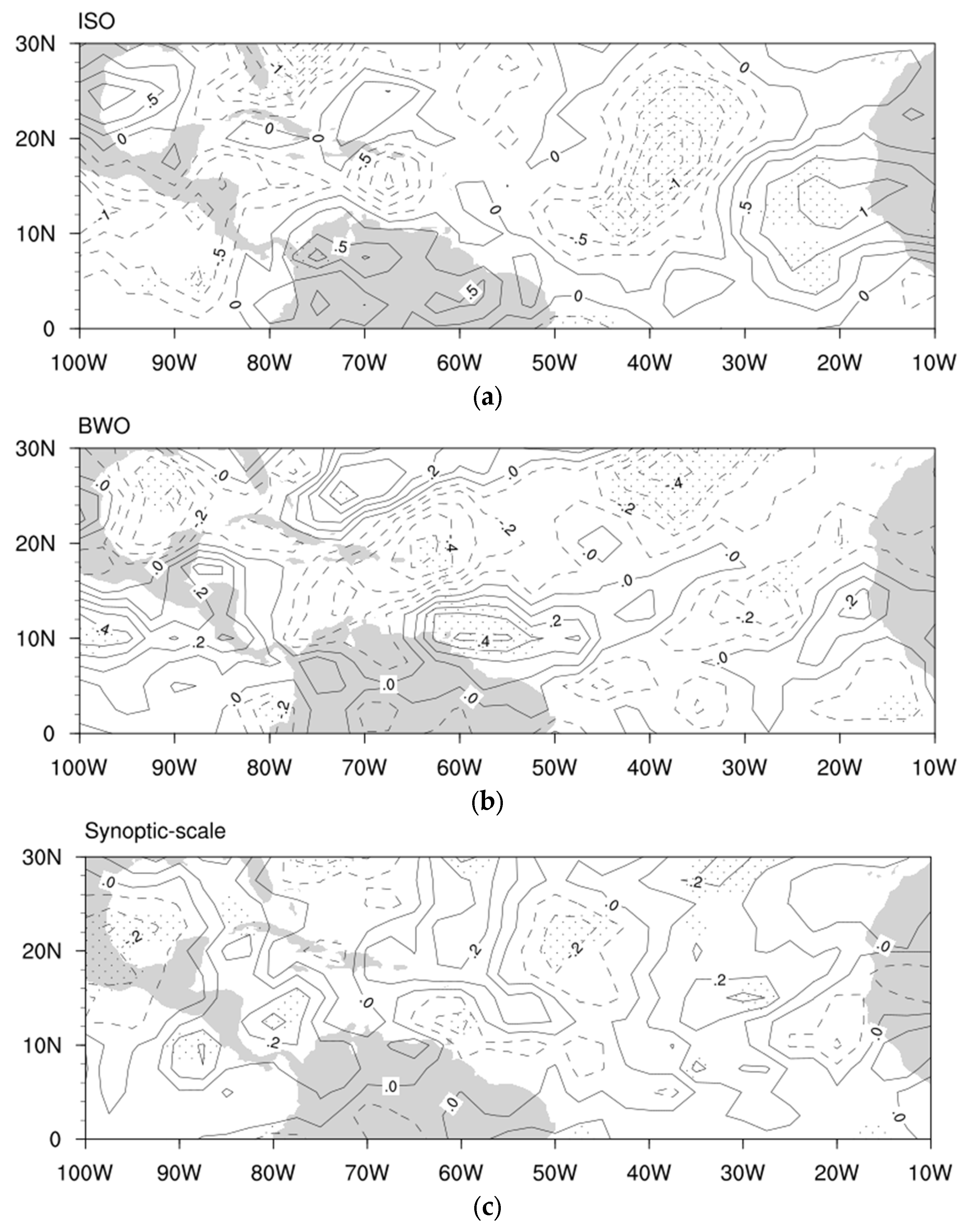
| 1950 4 | 1951 2 | 1952 4 | 1953 4 | 1954 4 | 1955 4 | 1956 1 | 1957 2 | 1958 3 | 1959 4 |
| 1960 2 | 1961 2 | 1962 1 | 1963 3 | 1964 2 | 1965 3 | 1966 5 | 1967 3 | 1968 3 | 1969 7 |
| 1970 6 | 1971 4 | 1972 3 | 1973 2 | 1974 5 | 1975 5 | 1976 4 | 1977 1 | 1978 2 | 1979 4 |
| 1980 4 | 1981 3 | 1982 0 | 1983 1 | 1984 3 | 1985 4 | 1986 1 | 1987 3 | 1988 4 | 1989 3 |
| 1990 5 | 1991 3 | 1992 1 | 1993 2 | 1994 2 | 1995 4 | 1996 2 | 1997 1 | 1998 2 | 1999 4 |
| 2000 4 | 2001 4 | 2002 3 | 2003 4 | 2004 5 | 2005 10 | 2006 2 | 2007 3 | 2008 4 | 2009 1 |
| 2010 5 | 2011 6 | 2012 6 | 2013 1 | 2014 1 | 2015 2 | 2016 4 | 2017 5 | 2018 4 | 2019 4 |
| 2020 8 |
Publisher’s Note: MDPI stays neutral with regard to jurisdictional claims in published maps and institutional affiliations. |
© 2022 by the authors. Licensee MDPI, Basel, Switzerland. This article is an open access article distributed under the terms and conditions of the Creative Commons Attribution (CC BY) license (https://creativecommons.org/licenses/by/4.0/).
Share and Cite
Sun, X.; Xie, L. A Climatological Study of Successive Tropical Cyclone Events in North Atlantic. Atmosphere 2022, 13, 1909. https://doi.org/10.3390/atmos13111909
Sun X, Xie L. A Climatological Study of Successive Tropical Cyclone Events in North Atlantic. Atmosphere. 2022; 13(11):1909. https://doi.org/10.3390/atmos13111909
Chicago/Turabian StyleSun, Xia, and Lian Xie. 2022. "A Climatological Study of Successive Tropical Cyclone Events in North Atlantic" Atmosphere 13, no. 11: 1909. https://doi.org/10.3390/atmos13111909
APA StyleSun, X., & Xie, L. (2022). A Climatological Study of Successive Tropical Cyclone Events in North Atlantic. Atmosphere, 13(11), 1909. https://doi.org/10.3390/atmos13111909







